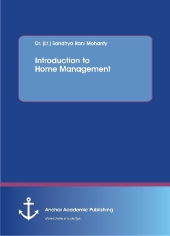 Neuerscheinungen 2016Stand: 2020-02-01 |
Schnellsuche
ISBN/Stichwort/Autor
|
Herderstraße 10
10625 Berlin
Tel.: 030 315 714 16
Fax 030 315 714 14
info@buchspektrum.de |

Sandhya Rani Mohanty
Introduction to Home Management
2016. 112 S. 220 mm
Verlag/Jahr: ANCHOR ACADEMIC PUBLISHING 2016
ISBN: 3-9606702-9-X (396067029X)
Neue ISBN: 978-3-9606702-9-2 (9783960670292)
Preis und Lieferzeit: Bitte klicken
Management plays a crucial role in day-to-day life. It is an inherent part of human life. Families in India have undergone vast changes over the years due to the rapid development of industries, educational achievements, the technological revolution and speedy communication. Each individual needs to be trained to fit himself in this changing environment by making the right decision at each moment of his or her life. In day-to-day life this is possible through the acquisition and application of knowledge of management.
´Text sample:
Chapter 4.1.1 Time Demands in Stages of Family Life Cycle:
The time demands change according to different stages of family life cycle. A family in the beginning stage with only two partners may have lesser time demands for the home maker. As the family size increases with the coming of children time management becomes most essential as she will be pressurized with lots of time demands for various activities. During the contracting stage of family life cycle the time demands of the home maker starts decreasing.
Understanding the demands on the homemaker´s time during the different stages of the family life cycle will help families plan ahead and prepare themselves to meet new and changing time demands.
Stage I: The beginning family is a period of adjustment and child bearing for young homemakers. At this stage, family goals, time and work patterns, work habits, and the division of responsibilities between husband and wife are established. Unless the homemaker is employed outside the home, demands on her time are light.
Stage II: The expanding family brings new and heavy demands on both the parents. The coming of children requires the greatest adjustment in the time patterns of homemakers. Farm and city homemakers with children under a year old used from twenty one to twenty five hours a week in caring for their families according to some studies. They used about thirteen hours when the youngest child was one to two years old. Thereafter their time demands decreased steadily until the youngest child was about nine years old. While children are in grade school and high school, their time demands, although different, remain high. They center around the problems of guiding and directing children in assuming their places as responsible members of the family, of making time plans together and helping each one to evaluate their use of time. As children approach and reach adulthood, demands on the homemakers time depend on whether the children go to college, marriage and leave home, or whether they take jobs and live at home.
Stage III: The contracting family covers the period during which the children have become independent. Mothers now have some free time to use as they wish. They can make the most of these years by learning to co-ordinate their time and recreation plans with those of their husbands. The curve in figure shows that the time demands upon the homemaker rise rapidly with the coming of children and remain high until the children complete their education and leave home. A gradual drop comes with the approach of the retirement period.
Managing the time involves both making the plan and carrying them out. A time plan shows what one expects to do in a given period of time. While making the time plan one has to think about the problems in advance, which can be prevented through careful planning. A time plan indicates the sequence of activities. To make an efficient, workable plan each home maker, with the help of her family members should decide what activities are to be carried out daily, weekly what season the task should be planed etc.
4.1.2 Pattern of Time Use and Time Norms:
As average home maker spends her time in various activities such as food preparation, dish washing, maintenance of home, care of family members, shopping, education of children, social and religious activities and managerial activities.
The pattern of time use is classified into two groups:
Work time and Leisure time.
- Work time:
Work is defined as activities producing measurable results for one´s self or others. The varieties of work time include time used for pay, household or home-related work, and volunteer work.
- Employment:
Time devoted to employment for pay is one category of work time. Employment time differs with the specific job. The specific nature of work hours influences the duration of non work activities and also affects s


